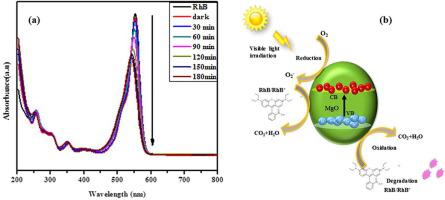Chemical Physics Letters ( IF 2.8 ) Pub Date : 2020-11-25 , DOI: 10.1016/j.cplett.2020.138216 K. Tharani , A. Jegatha Christy , Suresh Sagadevan , L.C. Nehru

|
Magnesium Oxide (MgO) nanoparticles represent one of the promising classes of nanomaterials owing to their lightweight property, biocompatibility, and rapid metabolic activity. Nanomaterials with such characteristics had been the most sought-after alternative to heavy metals for application in photodynamic and cancer therapy. The prime focus of this study is to investigate the toxicity and catalytic activity of morphologically different MgO NPs obtained by various fuel ratios. The synthesized MgO was characterized using UV–visible spectroscopy, X-ray diffraction, Fourier Transform-Infrared spectroscopy, and electron microscopic studies. The toxicity dependent parameters were evaluated using clinically significant Staphylococcus aureus (S. aureus) and Escherichia coli (E. coli) models. The feasibility of appending MgO for the photocatalytic effect was assessed using rhodamine dye. The maximum absorbance was obtained with a prominent peak absorbance were observed by UV–vis spectra. The corresponding band gap for MgO NPs was calculated using Tauc’s plot. From the X-ray diffraction (XRD) analysis, the MgO NPs are found to have formed in a face-centric cubic structure. The FTIR spectra confirms the successful formation of MgO NPs. The morphological analysis indicated the flakes-like structures and EDX for the elemental composition. There was a significant antibacterial effect on the tested strains at 10 μg/mL concentration as determined by MIC. The dye degradation efficiency of MgO was found significant in the presence of artificial light accomplished within 180 min of irradiating rhodamine dye.
中文翻译:

出于生物和环境原因,使用燃烧法制备氧化镁纳米粒子
氧化镁(MgO)纳米颗粒由于其轻质特性,生物相容性和快速的代谢活性而代表了有前途的一类纳米材料。具有这种特性的纳米材料一直是重金属在光动力和癌症治疗中的最抢手的替代品。这项研究的主要重点是研究通过各种燃料比获得的形态不同的MgO NP的毒性和催化活性。使用紫外-可见光谱,X射线衍射,傅立叶变换红外光谱和电子显微镜研究对合成的MgO进行了表征。使用临床上显着的金黄色葡萄球菌(S. aureus)和大肠杆菌评估毒性依赖性参数(大肠杆菌) 楷模。使用罗丹明染料评估了添加MgO进行光催化作用的可行性。通过紫外可见光谱观察到最大吸光度,并具有显着的峰吸光度。使用Tauc曲线计算MgO NP的相应带隙。通过X射线衍射(XRD)分析,发现MgO NP以面心立方结构形成。FTIR光谱证实了MgO NP的成功形成。形态分析表明片状结构和元素组成的EDX。通过MIC测定,在10μg/ mL的浓度下对测试菌株具有显着的抗菌作用。发现在照射若丹明染料的180分钟内完成的人造光存在下,MgO的染料降解效率显着。











































 京公网安备 11010802027423号
京公网安备 11010802027423号